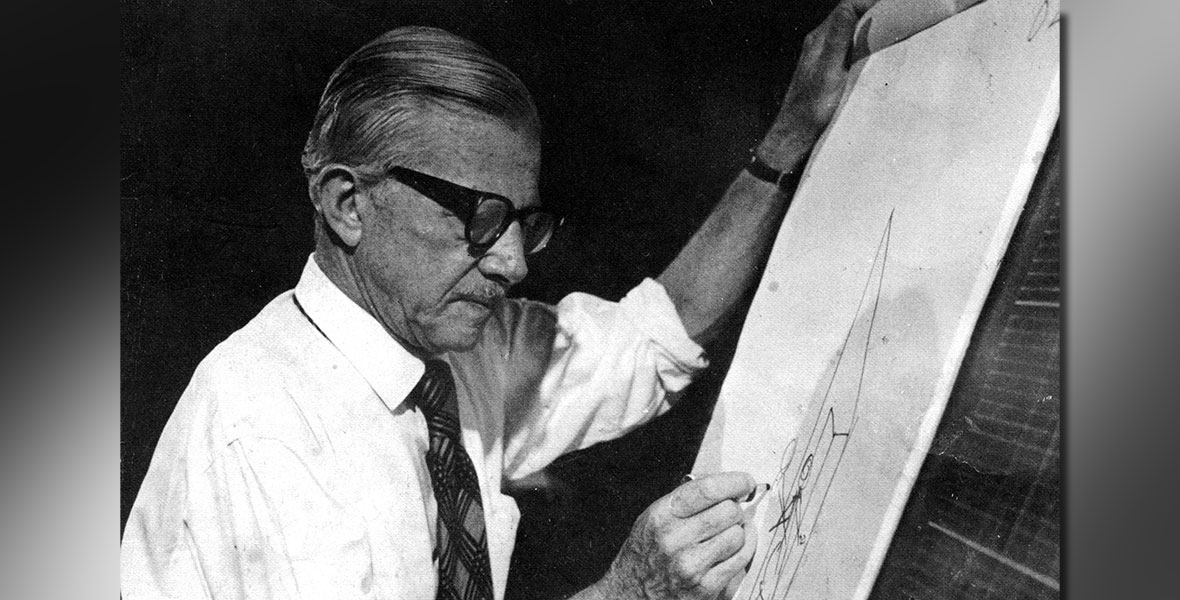As early as the 1942 publication of the first scholarly study of animation, The Art of Walt Disney by Dr. Robert Feild, Art Babbitt had gained a reputation as “The Greatest Animator Ever.” Art was not only a stellar “performer with a pencil,” but he was also a director, an activist, a tireless teacher, and—to this day—a remarkable influence in the field of animation.
Arthur Harold Babitsky was born on October 8, 1907, in Omaha, Nebraska. In 1912, his family relocated to Sioux City, Iowa, where, soon after high school, Art fell into drawing and crude animation to make ends meet. Soon he found he had a knack for the medium.
He went to New York to put himself through pre-med at Columbia College, but instead was inspired to become an animator when he saw Disney’s The Skeleton Dance. He got a job at the Van Beuren Studio, and then became an animator for Paul Terry. In 1932 he joined Disney, and by 1941 he was a top artist. He took the minor character Dippy Dawg and developed him into Goofy, and animated the Queen in Snow White and the Seven Dwarfs, Geppetto in Pinocchio, the Chinese Dance in Fantasia, and Mr. Stork in Dumbo.
“He studied the acting theories of internalization of Stanislavsky and Boleslavsky, as any actor of his time would,” animator Tom Sito later said. “Flinty, confrontational, indefatigable, and honest; straightforward to some, abrasive to others, Art was a warm friend and a tough opponent. He did things not because they were politic, but because they affected his sense of right and wrong,” Sito continued.
Walt felt betrayed when Art resigned as head of the Disney company union in 1941 to join the Screen Cartoonist’s Guild. Art led a bitter strike that forever changed the culture of the Studio, and Art and Disney were permanently estranged.
Art was a master sergeant in the Marines in World War II, after which he returned to Disney; he soon quit and wound up at UPA, where he was a principal animator on the acclaimed cartoon Rooty Toot Toot and several Mr. Magoo shorts. He later ran the advertising commercial department of Hanna-Barbera. In the 1970s, he worked with Richard Williams Studio in London. He retired in 1983.
“Art Babbitt was one of the great animation teachers,” Sito said.
“He had the ability to put into words the processes most animators only knew by instinct.”
Art lectured on animation throughout the 1960s and 1970s.
In 1973 Richard Williams suspended production so his artists could re-train under Art and his Warner Bros. colleague Ken Harris. Sito recalled, “Anybody who attended those lectures never forgot them. The notes from Art’s London lectures were copied and recopied until they became the most widely read—if unpublished—animation manual of all time.”
Stephen Worth posted a fond memory on the Animation Nation web site: “When Fantasia came out on home video,” Worth said, “Roy [E.] Disney sent Art a copy with a short note that said, ‘I want to give you long overdue thanks for your contribution to making Fantasia the classic film that it is.’ Art was very proud of that note. He told me that any animosity that he had harbored all those years against the Disneys was cleared up by that simple act of kindness on Roy’s part.”
Art Babbitt passed away on March 4, 1992, in Los Angeles, California.



